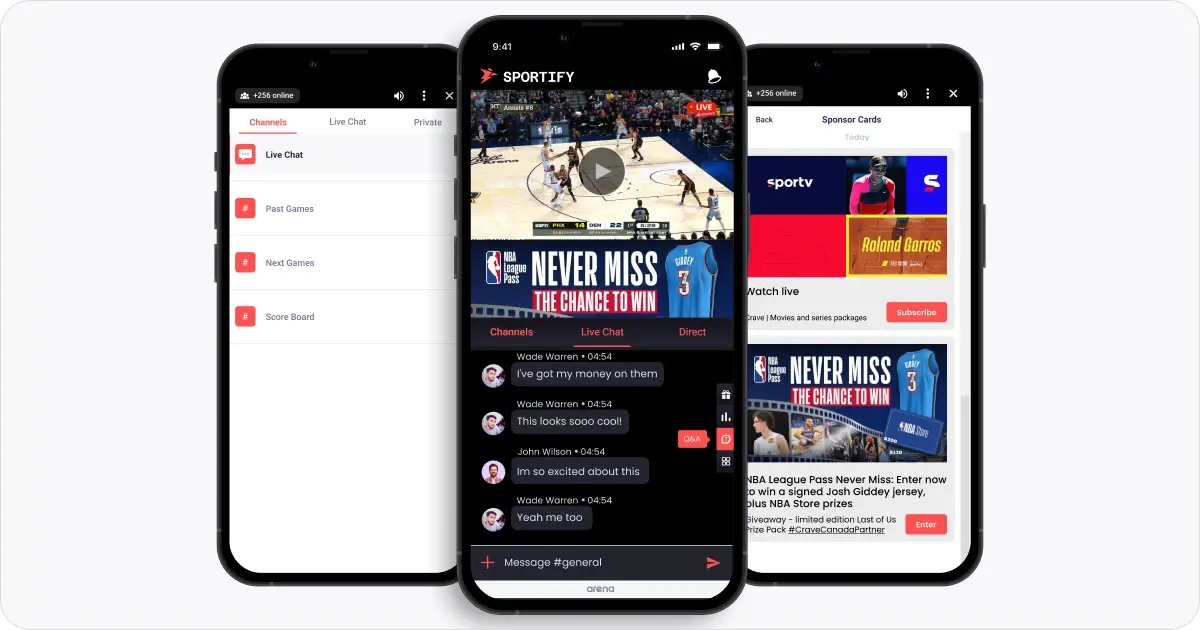

Keeping Gen Z and Millennials engaged with sports requires new strategies. Relying on a traditional TV broadcast to connect with fans is no longer enough. Find out new ways to reengage your younger audiences. The solution starts with understanding the rise of second-screen behaviors.
What Is The Second Screen Experience?
The data on TV and digital habits is clear. The majority of Gen Z (born 1997 to 2012) and Millenial (born 1981 to 1996) viewers are switching back and forth between their TV and other devices while watching. The smartphone is the primary second-screen device for most Gen Z and Millennials.
Switching back and forth between the TV and their phone is the new reality. You can either fight this tendency by insisting that audiences put down their phones, or you can adapt. There are only a few situations where asking people to switch off their phones is feasible, like live theater or movie theater. The best bet for sports is assuming your audience will check their phones during a game. The question is this: will they find your content or not?
Download our white paper “Generation Z and the Rise of the Second Screen” and transform your sports strategy today.
Sports Team Strategies
For sports teams, increasing fan engagement is critically important for a few reasons. Sports teams earn billions of dollars from ticket sales: an estimated $20 billion in 2019. There are also merchandise and other product sales to consider. Unfortunately, many in Gen Z – 47% – have never attended a pro sports game. That low attendance figure puts the industry’s future in question.
Adapting to changing viewing patterns starts with giving fans more opportunities to engage with your brand.
Leverage your athletes are creators
Start by looking for ways to involve your athletes in the creative process. Sports fans love understanding their favorite athletes’ daily life, training, and lifestyle. Take a look at Neymar Jr, a well-known Brazilian football player. His social media accounts have over 200 million followers. Some of his most popular online content includes a training video (over 250,000 views) and a video about his family story (1 million views).
While individual star athletes likely have the greatest name recognition, you don’t have to restrict yourself to those parts of your team. Clips and interviews with your team’s coaches, trainers, mascots, and others can create content. For example, check out Gritty – the official mascot of the Philadelphia Flyers – who has 1 million TikTok followers.
Host an ask me anything (AMA) for your fans
The chance to ask questions and connect with your athletes is another way to connect with your fans. Use live chat on your website to organize an ask-me-anything with fans – a great way to grow fan engagement right before your next game.
Second Screen Strategies for Publishers
Your approach to second-screen content and experiences depends on your assets. For publishers with broadcast rights or another onsite reporting presence, your second-screen experience should support the TV experience. For other publishers, you can create a few different kinds of coverage like reaction videos, or AMAs as described above.
1. Improve your short video experience
Short-form video content – think TikTok videos – are one of the most popular forms of media with Gen Z. According to a 2022 survey, Gen Z uses YouTube and TikTok more than any other social platform. Meet this preference by creating more short videos like short interviews, reactions, and highlights.
For inspiration, take a look at the NBA’s TikTok channel. The channel’s videos include classic content like highlights from games. Other videos include “Celeb Row In Miami,” – featuring the celebrity guests attending a Miami game.
To grow engagement further, use a mix of scheduled posts (i.e., explainer videos explaining the free agent process) and live posts (e.g., comment on a record-breaking game).
2. Explore the intersection of tech and sports

Innovations are coming to sports, and fans want to know more about it. For example, some sports coverage has recently looked at the impact of artificial intelligence (e.g., robot-umpires). There are other angles to explore, like advances in sports medicine to improve training and performance results.
Offering coverage on brand-new technologies – or including new technology directly – is a powerful way to make your coverage fresh and engaging. For example, Stats Perform offers performance analysis of more than 500 sports teams worldwide. This kind of data-driven sports coverage offers a new perspective.
3. Use a live blog to cover games

Most Gen Z and millennials watch TV with smartphones in their hand or nearby. The most popular second-screen behaviors include checking email, browsing social media, online shopping, chatting, and searching for information.
With these behaviors in mind, you can succeed online by giving your audience a timely mobile experience. A live blog is a great fit for a second-screen experience. Your audience can quickly look up the latest post, skim it for additional information, and then go back to watching TV.
A live blog is a great venue to invite sports influencers to participate in your coverage. One approach is to ask outside contributors to create content on a specific theme.
Take inspiration from the NFL, which invited Lisa Nguyen and Katie Feeney to create content related to the NFL draft in 2023. Working with influencers with millions of followers may be outside your budget. Fortunately, tools like Upfluence and Storyclash make it easy to search for influencers by audience size and other filters.
Inviting influencers to contribute to your coverage is a great way to augment your in-house talent. Even better, working with Gen Z influencers goes a long way to unlocking Gen Z audience engagement.
How To Launch Your Second-Screen Experience Quickly
Designing a detailed strategy for second-screen engagement may be wise if you’re working on a high-profile event like the Super Bowl. In other situations, there’s significant value in just getting started, launching a second-screen experience fast, and seeing what kinds of experiences resonate with your audience.
Launching a second-screen experience on your website is fast and easy with Arena. You can install Arena in minutes without any development resources. Find out more about how Arena helps publishers and brands build online communities.



